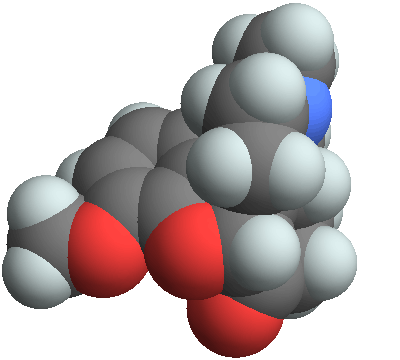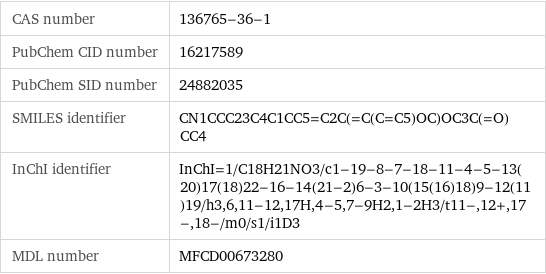Input interpretation

hydrocodone-N-methyl-d 3solution
Chemical names and formulas

formula | C_16H_15O_2(OCH_3)NCD_3 Hill formula | C_18H_18D_3NO_3 name | hydrocodone-N-methyl-d 3solution mass fractions | O (oxygen) 0.159% | N (nitrogen) 0.0463% | C (carbon) 0.715% | H (hydrogen) 0.08%
Lewis structure

Draw the Lewis structure of hydrocodone-N-methyl-d 3solution. Start by drawing the overall structure of the molecule, ignoring potential double and triple bonds: Count the total valence electrons of the carbon (n_C, val = 4), hydrogen (n_H, val = 1), nitrogen (n_N, val = 5), and oxygen (n_O, val = 6) atoms: 18 n_C, val + 21 n_H, val + n_N, val + 3 n_O, val = 116 Calculate the number of electrons needed to completely fill the valence shells for carbon (n_C, full = 8), hydrogen (n_H, full = 2), nitrogen (n_N, full = 8), and oxygen (n_O, full = 8): 18 n_C, full + 21 n_H, full + n_N, full + 3 n_O, full = 218 Subtracting these two numbers shows that 218 - 116 = 102 bonding electrons are needed. Each bond has two electrons, so in addition to the 47 bonds already present in the diagram add 4 bonds. To minimize formal charge oxygen wants 2 bonds and carbon wants 4 bonds. Identify the atoms that want additional bonds and the number of electrons remaining on each atom: Fill in the 4 bonds by pairing electrons between adjacent highlighted atoms. Note that the six atom ring is aromatic, so that the single and double bonds may be rearranged: Answer: | |
3D structure

3D structure
Basic properties

molar mass | 302.39 g/mol
Units

Non-standard atom properties

H-2 | 3
Chemical identifiers

CAS number | 136765-36-1 PubChem CID number | 16217589 PubChem SID number | 24882035 SMILES identifier | CN1CCC23C4C1CC5=C2C(=C(C=C5)OC)OC3C(=O)CC4 InChI identifier | InChI=1/C18H21NO3/c1-19-8-7-18-11-4-5-13(20)17(18)22-16-14(21-2)6-3-10(15(16)18)9-12(11)19/h3, 6, 11-12, 17H, 4-5, 7-9H2, 1-2H3/t11-, 12+, 17-, 18-/m0/s1/i1D3 MDL number | MFCD00673280